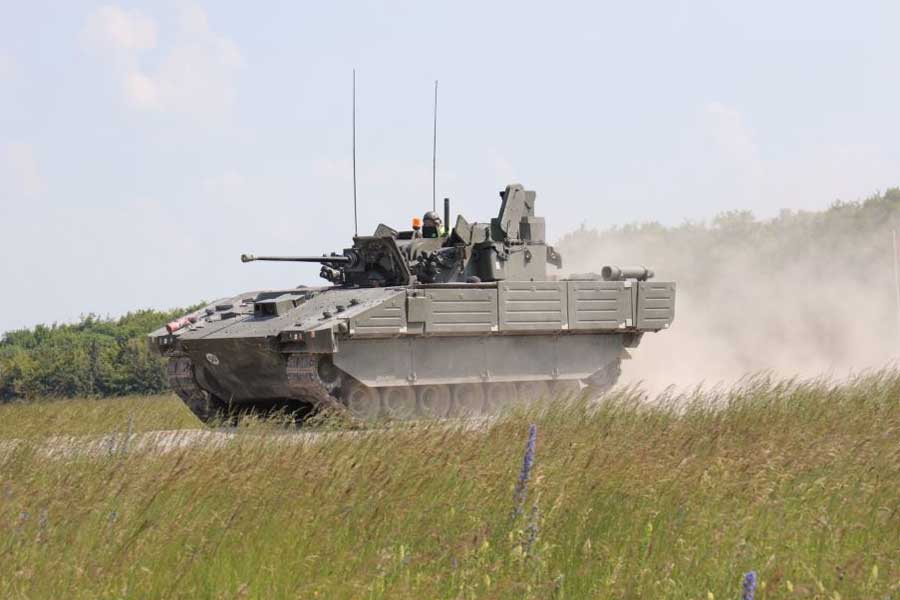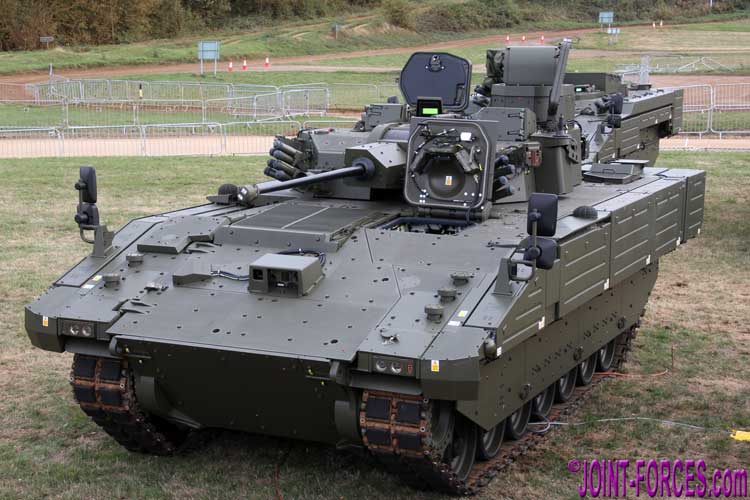Units of the British Field Army have restarted training on the AJAX vehicles this week, highlighting continued progress in the programme.
~
Press Release, Whitehall, 15 June 2023: Units of the British Field Army have restarted training on the AJAX vehicles this week, highlighting continued progress in the programme.
Focused on individual and crew training, this step will mark the restarting of British Army training on the sophisticated vehicles. Conducted in Bovington and Bulford on the initial production standard of AJAX vehicles – Capability Drop 1 – this training will enable troops to learn how to operate the armoured vehicles and use the systems integrated into them. The training will also enable the crew to develop skills and experience with the vehicles before delivery of the later Capability Drop 3 vehicles, which will be fully deployable.
44 vehicles at Capability Drop 1 have been delivered to the British Army, while a busy production line in South Wales manufactures the Capability Drop 3 vehicles that will provide the British Army with a battle-winning edge.
Delivering a step-change in the surveillance and reconnaissance capability for the Army, with its suite of cutting-edge sensors, enhanced 40mm cannon, modular armour, and improved cross-country range and mobility, the programme will deliver 6 variants, totalling 589 vehicles that will allow the Army to operate in all weathers, 24 hours a day.
Boosting the Prime Minister’s priority to grow the economy, the main AJAX contracts supports a UK-wide supply chain of more than 230 UK-based companies and more than 4,000 jobs throughout the UK, including a large number in South Wales.
Minister for Defence Procurement, James Cartlidge, said: “This is a significant moment for the British Army, marking a huge step forward for the AJAX Programme. The AJAX vehicles will provide a breakthrough in capability and I’m pleased to see such positive progress towards delivering a suite of battle-ready vehicles for our forces.”
Visiting Bovington Camp in the south west of England – where soldiers are currently training on the AJAX vehicles – Defence Minister James Cartlidge recently met with soldiers taking part in the Reliability Growth Trials that resumed earlier this year and instructors who were about to start training the Army.
Through Reliability Growth Trials, AJAX, APOLLO, ATLAS and ARES variants have driven more than 6,600 kilometres through different terrains, completing a variety of representative battlefield tasks such as operating across a range of speeds, firing weapon systems, using the vehicles systems and communications and completing specialist tasks such as vehicle recoveries and repairs using the integrated crane.
Earlier this year, the MOD also confirmed the resumption of payments to General Dynamics for the delivery of the programme. A robust firm price contract remains for the delivery of the 589 vehicles, which will ensure that General Dynamics are incentivised to deliver against agreed outcomes.
As such, the whole programme remains within its originally approved budget level and the Department has worked collaboratively and constructively with General Dynamics to achieve this.
~
Updated with Ministerial Statement on Ajax Lessons Learned Review
UK Minister for Defence Procurement, James Cartlidge, delivered a statement on the publication of the Ajax Lessons Learned Review
~
Oral Statement to Parliament , 15 June 2023: With permission, I would like to make a statement to update the House on the review, conducted by Clive Sheldon KC, into the lessons to be learned from the Armoured Cavalry Programme, which is the Army programme centred on the Ajax vehicles.
The Defence Secretary has previously acknowledged the programme was a troubled programme. And, albeit he has more recently announced it has turned a corner, it is against the concerns he had of the programme, and those of this House about what was known at the time of publishing the Integrated Review, that the Defence Secretary commissioned an independent review by a senior legal figure to investigate the circumstances.
In May last year, Clive Sheldon KC was appointed to lead a lessons learned review into the Armoured Cavalry Programme. The terms of reference of the Review were to, and I quote: “identify lessons and make recommendations to help the Ministry of Defence (MoD) deliver major programmes more effectively in future, with a particular focus on how MoD shares and elevates issues across the Department.” An earlier MoD report, by David King, specifically relating to the health and safety concerns around noise and vibration, was published in December 2021. We continue to make good progress implementing the recommendations from that report, some of which are echoed in Mr Sheldon’s Review. Now, Mr Sheldon submitted his report to Ministers on 19 May, and I am today publishing that report, unredacted, on gov.uk and placing a copy in the Library of the House.
First of all, I would like to formally thank Mr Sheldon and his team for the painstaking work they have undertaken to enable us to better understand how the MoD can improve the governance, culture and leadership of our major programmes. They interviewed some 70 people and considered tens of thousands of pages of evidence.
The resulting report makes for difficult reading, highlighting a number of systemic, cultural and institutional problems across several areas of the department. These problems include fragmented relationships and the conflicting priorities of the Senior Responsible Owner – or SRO – role. It also points to a reticence to raise, and occasionally by seniors to listen to, genuine problems, in a timely evidenced manner.
Now, we accept these findings and most of Mr Sheldon’s 24 formal recommendations, with 15 Accepted and 9 Accepted in Principle.
Crucially, the Review did not find that either Ministers or Parliament were misled. Equally, the Review Team did not see any evidence of misconduct by any individual, let alone gross misconduct, and nothing that would justify any disciplinary action.
It is, though, true that many of the behaviours highlighted in the report are far from ideal, but in many cases they have already been recognised and acted on, both specifically on the Armoured Cavalry Programme as well as across the department. Where work is not already underway to implement a recommendation, we commit to making the necessary changes at pace. In the interest of time, Madam Deputy Speaker, I will address the recommendations in the themes set out by Mr Sheldon in his Executive Summary, rather than going through each of the recommendations.
A number of recommendations relate to MoD’s internal relationships, including with the Defence Science and Technology Laboratory (DSTL). Considerable effort has already been made to address these issues within and beyond the Ajax programme. This has resulted in much improved working and reporting arrangements, in particular with the Defence Equipment and Support organisation (DE&S) and also the newly established Acquisition Safety Cell that advises the Investment Approvals Committee on equipment safety matters. Escalation routes also exist for DSTL through the Chief Scientific Advisor where concerns are not acted on.
As said, another area of focus is SROs and I know a lot of colleagues are interested in this point. We fully agree with the need to improve how Senior Responsible Owners are supported and much work has gone into upskilling and supporting SROs, ensuring they have the time and space to focus on delivering their programmes and can build skills through the Major Projects Leadership Academy. Today, four in every five of our major project SROs are committing at least half of their time to leading their programmes – half of the Army’s 19 SROs dedicate 100% of their time. We also agree in principle with Mr Sheldon’s presumption for a minimum tenure, subject to compatibility with employment law.
Finally, the Report comments extensively on a culture that led to issues not being escalated and makes recommendations to improve that and the flow of information. Transparency has improved since the period of this report. For Ajax, there are detailed updates through the SRO to Ministers that ensures the potential issues are exposed early should they arise in the future. Processes will be further strengthened through the defence acquisition operating model and guidance. Work is also underway to implement a Project Delivery Data Strategy to strengthen the use of data to both support performance reporting and assist in early identification of issues.
Of course, the main aim of commissioning this Review was to learn lessons to improve procurement – not just on Ajax but across MoD’s programmes. Ultimately at the core of our intent is to ensure the equipment we procure for the British Armed Forces is of the highest possible standard and, furthermore, that our service personnel have faith in the system and the taxpayer faith in the money we spend from the public purse. Quite simply, we need to deliver change across the department, turning widespread desire for acquisition reform into tangible reality, in particular driving increased pace and agility into acquisition so that we are able to keep pace with technology, and maintain our competitive edge.
Madam Deputy Speaker, whilst I recognise the many challenges in this programme to date and the need to learn lessons, I would stress that there is already intense work underway in the department – especially at DE&S – to improve performance, with encouraging signs. For example, between December 2020 to December 2022 we saw a reduction from 6.1 years to 5.1 years in the time it takes to go from Outline Business Case to actually delivering equipment into the hands of our Armed Forces.
In further positive news, I hope the House will welcome the significant progress made to recover the Ajax programme. I am able to confirm that as of Tuesday afternoon the Household Cavalry has been undergoing standard army field training on Salisbury Plain in a range of Ajax vehicles.
Focused on individual and crew training, this step marks the restarting of British Army training on these sophisticated vehicles, and I hope underlines that this project really has turned the corner.
Indeed, last Friday I had the great privilege Madam Deputy Speaker to visit Bovington to experience the Ajax vehicle at first hand. I am pleased to report how the soldiers I met described the vehicle and its capabilities as, I quote, ‘night and day’ when compared to their current equipment. That phrase was used repeatedly. In describing Ajax’s strengths, the soldiers I spoke to emphasised the platform’s high mobility; increased firepower from the new cannon; and a highly sophisticated sensor suite that really helps them do their job, representing in totality a very real and positive step change in capability. All of this packaged in a vehicle with high levels of crew protection and survivability.
As training increases across other Field Army units on the 44 vehicles already delivered, in parallel General Dynamics’ personnel in Wales continue to run their production lines to build the fully operationally deployable vehicles – with the end goal of 589 fully operational vehicles by 2029.
In conclusion, I would like to reiterate my gratitude to Mr Sheldon and his team for their considerable efforts, and for distilling his findings into clear lessons and recommendations for the future. Our focus now is on understanding and applying those lessons, ensuring that they are implemented in the Armoured Cavalry and other major defence programmes, as well as ensuring we deliver the game-changing capability that Ajax will provide the British Army as quickly as possible. I commend this statement to the House.
~ $ ~
- Further reading:- AJAX





















